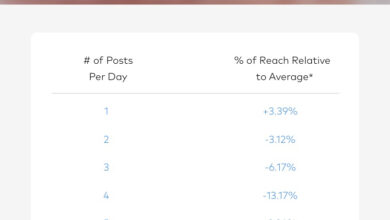
Social Media Management for Environmental Organizations A Guide
Social media management for environmental organizations is crucial for raising awareness, building community, and driving action. Different environmental groups, from advocacy groups to research institutions, can leverage various platforms like Instagram, Facebook, X, and YouTube to achieve specific objectives. Effective strategies involve audience analysis, engaging content creation, fostering community, and measuring results to maximize impact.
This guide delves into the specifics of crafting impactful social media campaigns for environmental causes. It covers content creation strategies, community building tactics, and performance measurement frameworks to equip organizations with the tools needed for success. Understanding how to navigate challenges and leverage opportunities is also explored.
Defining the Scope of Social Media Management for Environmental Organizations
Social media has become an indispensable tool for environmental organizations, enabling them to connect with wider audiences, raise awareness, and drive impactful change. Effective social media management goes beyond simply posting updates; it requires a strategic approach tailored to the specific goals and target audience of each organization. Understanding the diverse needs of different environmental groups is key to maximizing the impact of their online presence.Environmental organizations leverage social media to build communities, share information, mobilize support, and advocate for policies that protect our planet.
This involves everything from promoting conservation efforts to raising awareness about climate change and pollution. The specific strategies and platforms employed will vary based on the type of organization and its unique objectives.
Key Objectives and Goals
Environmental organizations utilize social media to achieve a range of objectives. These include raising awareness about environmental issues, mobilizing support for conservation efforts, fostering public engagement, and promoting sustainable practices. Organizations often aim to educate the public about environmental threats and solutions, encourage donations and volunteerism, and advocate for policy changes. Ultimately, their goal is to inspire action and drive positive change in the world.
Types of Environmental Organizations and Their Strategies
Different environmental organizations will adopt varying social media strategies. Advocacy groups, for example, may prioritize engaging in public discourse, sharing compelling stories, and mobilizing support for specific campaigns. Conservation charities may focus on showcasing the beauty of nature, highlighting the importance of biodiversity, and appealing to a broader audience to support their work. Research institutions might emphasize sharing their findings, engaging with experts and academics, and fostering a sense of intellectual curiosity about environmental science.
This diversity in approach is crucial for effective engagement across various environmental communities.
Want to boost your environmental org’s social media presence? A crucial part of that is getting your Instagram account noticed. Knowing how to get verified on Instagram is key for credibility and reaching a wider audience. Following these 7 essential steps can help you stand out from the crowd, how to get verified on instagram 7 essential steps , and then, you can use that verified status to share vital information and connect with more people who care about protecting our planet.
Effective social media management for environmental organizations relies on strategic use of platforms like Instagram to spread awareness and inspire action.
Social Media Platforms and Their Suitability
The choice of social media platform depends heavily on the specific objectives and target audience of the environmental organization. Instagram, with its visually-driven format, is ideal for showcasing nature’s beauty and inspiring action through captivating images and videos. Facebook offers a broader reach, allowing for detailed information sharing, community building, and running targeted advertising campaigns. X (formerly Twitter) remains a vital platform for real-time updates, engaging in discussions, and disseminating critical news related to environmental issues.
Crafting a strong social media presence for environmental groups is crucial. Think about how effective social media management can be for raising awareness about crucial issues. Learning from reliable social media management for real estate agencies, like this excellent resource , can provide valuable insights. Ultimately, mastering these techniques can help environmental organizations connect with their audiences effectively.
YouTube excels in providing detailed explanations, educational videos, and documentaries, making it a valuable platform for in-depth content delivery. Each platform has unique strengths and weaknesses, making it critical to select platforms aligned with the organization’s specific goals.
Social media management for environmental organizations is crucial, but don’t forget the power of email newsletters! To keep your subscribers engaged, check out some awesome design inspiration for email newsletters at email newsletter design inspiration engage subscribers. High-quality visuals and compelling content in your newsletters can complement your social media strategy, boosting your overall impact. Ultimately, a strong email strategy, combined with effective social media management, is a winning combination for environmental groups.
Audience Analysis for Effective Campaigns
Understanding the demographics, interests, and online behavior of the target audience is essential for creating effective social media campaigns. A deep dive into audience analysis allows organizations to tailor their messaging and content to resonate with their specific audience. This involves researching relevant hashtags, understanding what information the audience is actively seeking, and recognizing the best ways to reach them.
By carefully analyzing the audience, environmental organizations can craft more impactful campaigns that drive genuine engagement and inspire action.
Content Creation Strategies for Environmental Advocacy
Crafting compelling content is crucial for environmental organizations to effectively raise awareness and inspire action. Engaging narratives, coupled with clear communication of scientific data, can drive significant impact on social media. This involves more than just posting; it requires a strategic approach to various content formats, tailored to different platforms, to maximize reach and resonance. By incorporating diverse voices and perspectives, environmental organizations can foster deeper understanding and broader support for their causes.Effective social media content for environmental advocacy goes beyond simple information dissemination.
It requires understanding audience needs, using compelling visuals, and fostering a sense of community around shared environmental concerns. The key lies in storytelling that connects with audiences on an emotional level, inspiring them to take action.
Engaging Content Formats for Awareness
Environmental issues often require complex scientific explanations. To effectively communicate these ideas, creative content formats are essential. Visuals such as infographics, videos, and stories can convey information concisely and powerfully. Live streams provide real-time interaction and engagement.
- Infographics are particularly well-suited for summarizing complex data, presenting statistics, or highlighting environmental trends. For instance, an infographic depicting the impact of plastic pollution on marine life can effectively convey the gravity of the issue in a visually appealing manner.
- Videos, especially short-form ones, are extremely engaging on platforms like Instagram and TikTok. Short video clips can highlight specific environmental issues, showcasing the impact on local communities or showcasing inspiring stories of environmental activism.
- Stories allow for a more intimate and personal approach to environmental advocacy. Organizations can use Instagram and Facebook stories to feature individual stories of environmental heroes, highlight local conservation efforts, or offer practical tips for reducing one’s environmental footprint.
- Live streams are ideal for real-time discussions, Q&A sessions with experts, or virtual events. A live stream showcasing a field trip to a local nature preserve or an interview with a conservationist can generate immediate interest and engagement.
Effective Content Strategies for Specific Causes
Promoting specific environmental causes often requires tailored strategies. A campaign focused on reducing deforestation might feature stories of indigenous communities protecting their ancestral lands. Highlighting the cultural and economic value of these forests, combined with visual elements of deforestation’s impact, can drive greater public support. A campaign about plastic pollution could showcase the innovative solutions of local recycling initiatives.
- A campaign focused on renewable energy could feature testimonials from communities transitioning to solar power, emphasizing the economic and environmental benefits.
- Another campaign centered on biodiversity conservation could highlight the interconnectedness of species and ecosystems through stunning visuals and captivating narratives.
Communicating Scientific Data and Research Findings
Effective communication of scientific data and research findings is paramount for environmental advocacy. Different approaches are suitable for various platforms and audiences. For example, using interactive charts and graphs on X or Facebook can present data in an easily digestible format. In contrast, detailed explanations of scientific studies can be provided in blog posts on websites.
- Interactive elements, such as quizzes or polls, can engage audiences with scientific concepts in a fun and interactive way.
- Visualizations of data, like graphs and charts, can quickly communicate complex information in a compelling manner.
- videos can break down complex scientific concepts into easily understandable segments, making them accessible to a broader audience.
Content Format Suitability
The choice of content format directly impacts its effectiveness on various social media platforms. A table below illustrates the suitability of different content formats for different platforms.
| Content Format | Platform Suitability |
|---|---|
| Infographics | Instagram, Facebook, X |
| Short Videos | Instagram, TikTok, X, YouTube |
| Long-Form Videos | YouTube |
| Blog Posts | Website, X, Facebook |
| Stories | Instagram, Facebook |
Incorporating Diverse Perspectives and Voices
Enhancing representation and inclusivity is essential for effective environmental advocacy. Environmental organizations should actively seek and feature diverse voices, including those from marginalized communities. This might involve collaborating with indigenous communities, featuring stories of young environmental activists, or amplifying voices from developing nations.
- Amplifying the voices of marginalized communities in environmental conversations can foster a sense of shared responsibility and action.
- Actively seeking out and featuring diverse perspectives is critical to ensuring the inclusivity and impact of environmental advocacy efforts.
Building Community and Engagement
Connecting with your audience on social media isn’t just about broadcasting; it’s about fostering a two-way conversation. Environmental organizations can leverage social media to build a strong, engaged community that supports their mission and amplifies their message. This requires a proactive approach to responding, creating opportunities for interaction, and consistently demonstrating genuine interest in your followers.Effective social media management for environmental organizations goes beyond simply posting updates.
It’s about building a community where followers feel heard, valued, and inspired to take action. This involves creating a welcoming environment where dialogue thrives and shared experiences reinforce a collective commitment to environmental protection.
Strategies for Fostering a Sense of Community
Building a strong sense of community requires active engagement. This involves recognizing and valuing your followers’ contributions, creating opportunities for interaction, and showcasing the impact of their involvement. Regularly share success stories, testimonials, and photos of volunteer events to inspire and motivate others.
Best Practices for Responding to Comments and Messages
Responding to comments and messages is crucial for fostering a sense of community. Acknowledge every comment, even if it’s just a simple “thank you.” Engage with questions and concerns promptly and thoughtfully, demonstrating that you value their input. Avoid automated responses; instead, tailor your replies to individual comments for a more personal touch. This proactive engagement builds trust and strengthens the community bond.
Actively participate in relevant conversations and address criticism constructively.
Methods for Running Contests, Polls, and Q&A Sessions
Interactive content is a powerful tool for increasing engagement. Contests can boost participation and raise brand awareness. Polls can gather valuable insights into your audience’s interests and priorities. Q&A sessions allow for direct interaction, facilitating knowledge sharing and building rapport. Use clear guidelines and a compelling prize for contests to attract more entries.
Ensure polls cover topics relevant to your audience and present results transparently. Prepare well-structured Q&A sessions with experts to provide valuable insights and address audience concerns.
Examples of Successful Community Engagement Strategies
Many environmental organizations have successfully leveraged social media to build thriving communities. For instance, the World Wildlife Fund often uses live streams to share real-time updates on conservation efforts, fostering a direct connection with their audience. Similarly, the Sierra Club frequently runs contests and polls to engage followers on environmental issues, creating a platform for discussion and advocacy.
These examples showcase the power of interactive content in fostering a sense of community and inspiring action.
Comparing Different Engagement Tactics
| Engagement Tactic | Potential Impact |
|---|---|
| Contests | Increased participation, brand awareness, and potentially new followers |
| Polls | Data collection, insights into audience priorities, and fostering discussion. |
| Q&A Sessions | Increased follower interaction, knowledge sharing, and building credibility. |
| Live Streams | Real-time interaction, building trust, and fostering a sense of connection. |
Measuring and Evaluating Social Media Performance
Understanding the impact of your social media efforts is crucial for optimizing future strategies. Tracking key metrics allows environmental organizations to refine their approach, understand audience engagement, and demonstrate the effectiveness of their campaigns to stakeholders. This data-driven analysis is essential for allocating resources efficiently and maximizing the reach of your message.Analyzing social media performance is not just about counting likes; it’s about understanding the story behind the numbers.
A deep dive into engagement, reach, and sentiment allows you to identify what resonates with your audience, refine content strategies, and ultimately drive meaningful change. This detailed understanding translates into more impactful campaigns that connect with your target audience and contribute to a larger environmental movement.
Key Performance Indicators (KPIs) for Social Media Campaigns
Tracking specific metrics allows you to gauge the effectiveness of your campaigns. Consistent monitoring of these indicators provides a clear picture of how your strategies are performing. This information is vital for adjusting tactics and optimizing future efforts.
- Reach: This metric indicates the number of unique users exposed to your content. Tracking reach provides insights into the potential audience size of your posts. Monitoring reach over time helps determine the effectiveness of promotional strategies and the overall growth of your social media presence.
- Engagement: Likes, comments, shares, and retweets are key indicators of audience interest and interaction. High engagement signifies that your content resonates with your target audience, leading to increased visibility and brand awareness.
- Website Traffic: Social media platforms often serve as gateways to your website. Monitoring website traffic from social media sources helps identify which posts and campaigns are driving users to your platform, offering insights into effective content formats and strategies.
- Brand Mentions: Tracking how often your organization is mentioned on social media offers valuable insights into brand awareness and public perception. This can reveal positive or negative sentiment associated with your organization, helping you understand public opinion and address any concerns.
Analyzing Content Effectiveness
Different content formats can attract different types of engagement. Understanding how various content types perform is crucial for tailoring future strategies.
- Visual Content: High-quality images and videos often generate higher engagement rates. Analyze the performance of different visual styles to optimize future content creation.
- Text-Based Content: Well-written posts and articles can drive meaningful discussions and engagement. Track the performance of different text-based content types, such as blog posts or articles, to understand what formats attract the most engagement and attention.
- Interactive Content: Quizzes, polls, and Q&A sessions encourage active participation. Analyze the response rates and feedback from these formats to identify audience preferences and generate more interactive content.
Social Listening and Sentiment Analysis
Monitoring social media conversations is crucial for understanding public opinion and addressing concerns. Sentiment analysis can reveal the overall public perception of your organization and specific campaigns.
- Social Listening Tools: Tools like Brandwatch and Sprout Social allow for tracking social media mentions and analyzing the sentiment surrounding your organization. These tools help to identify key conversations and track mentions of your brand.
- Sentiment Analysis: Tools can assess the tone of social media conversations. Positive sentiment suggests favorable public opinion, while negative sentiment reveals areas needing improvement. Sentiment analysis helps identify emerging issues and potential risks, allowing for proactive management of public perception.
Improving Strategies with Data Analysis
Analyzing social media data is a continuous process that provides insights into campaign performance and public perception.
- Identify Trends: Identify recurring themes and patterns in social media conversations to uncover audience interests and preferences.
- Refine Content Strategy: Use data to refine your content strategy by identifying what resonates most with your audience. This can involve tailoring content formats, themes, and posting times.
- Adapt Campaigns: Analyzing campaign performance allows for adjustments in content, messaging, and timing. Adapt to trends and audience preferences for more effective communication.
KPI Tracking Table
| KPI | Tracking Method |
|---|---|
| Reach | Social media platform analytics |
| Engagement | Likes, comments, shares |
| Website Traffic | Google Analytics |
| Brand Mentions | Social listening tools |
Addressing Challenges and Opportunities in Social Media Management

Navigating the digital landscape presents unique challenges for environmental organizations, but also incredible opportunities for positive impact. Social media platforms are powerful tools for raising awareness, mobilizing action, and fostering dialogue, but effective use requires careful consideration and strategic planning. This section will delve into common hurdles, strategies for managing criticism, combating misinformation, and harnessing social media’s potential for environmental advocacy.Effective social media management for environmental organizations necessitates a deep understanding of both the platform’s capabilities and the challenges inherent in the field.
This involves not just posting engaging content, but also proactively addressing potential issues and fostering a supportive online community. The following sections Artikel key aspects of this strategic approach.
Common Challenges Faced by Environmental Organizations
Environmental organizations often face difficulties in managing their social media presence due to a variety of factors. These range from limited resources and staff expertise to the inherent complexity of environmental issues and the challenge of maintaining an authentic voice in a saturated digital space. The need to balance scientific accuracy with compelling storytelling, and to maintain consistent engagement with diverse audiences, can also present hurdles.
- Limited Budget and Resources: Many environmental organizations operate on tight budgets, which can restrict their ability to invest in professional social media management, targeted advertising campaigns, or dedicated staff time for social media engagement. This limitation can hinder the ability to reach a broader audience and effectively communicate complex environmental issues.
- Maintaining Consistency and Authenticity: Maintaining a consistent brand voice and message across multiple platforms while staying true to the organization’s values can be challenging, especially when dealing with diverse audiences and topics. The need to ensure accuracy and avoid spreading misinformation is a key factor in maintaining authenticity.
- Managing Negative Feedback and Criticism: Public discussions on environmental issues can sometimes involve strong opinions and criticism. Handling these comments in a professional and constructive manner is crucial for maintaining a positive online reputation and fostering trust with the public.
Approaches to Managing Negative Feedback
Negative feedback and criticism are inevitable on social media, particularly for organizations tackling controversial issues. A reactive and defensive approach often exacerbates the problem. A proactive, constructive approach is crucial for mitigating negative impacts and potentially turning critics into allies.
- Responding with Empathy and Respect: Acknowledge criticism even if you don’t agree with it. Empathetic responses that show understanding and a willingness to listen can often diffuse tense situations. Avoid resorting to personal attacks or defensiveness.
- Addressing Concerns with Facts and Data: When possible, back up your statements with factual information and credible scientific data. Providing accurate information can help address misinformation and foster trust.
- Offering Opportunities for Dialogue: Engage in constructive dialogue with critics, even if it means admitting shortcomings or clarifying misunderstandings. This approach fosters a sense of collaboration and encourages a more nuanced understanding of the issue.
Combating Misinformation and Disinformation, Social media management for environmental organizations
The spread of misinformation and disinformation is a significant challenge for environmental organizations. These inaccuracies can undermine public trust, create confusion, and hinder efforts to promote environmental action. Identifying and countering these inaccuracies requires a multi-pronged approach.
- Fact-Checking and Verification: Partnering with fact-checking organizations or developing internal fact-checking processes is essential. Actively debunking false claims with verifiable information is key.
- Highlighting Credible Sources: Promote and share information from reputable scientific journals, research institutions, and environmental organizations to provide context and counter misinformation.
- Collaborating with Journalists and Media Outlets: Engage with journalists and media outlets to ensure accurate reporting on environmental issues and to correct misinformation.
Mobilizing Public Support for Environmental Action
Social media offers a powerful platform for mobilizing public support for environmental action. Effective use of social media can help to raise awareness, inspire action, and create a sense of community among supporters.
- Creating Engaging Content: Share compelling stories, visual content, and interactive posts to captivate audiences and encourage engagement.
- Building a Community: Foster a sense of community among followers by creating opportunities for dialogue and interaction.
- Organizing Online Events and Campaigns: Organize online events, campaigns, and petitions to encourage participation and collective action.
Opportunities for Collaboration
Collaboration between environmental organizations and other stakeholders is crucial for achieving widespread environmental action. Social media provides a platform for fostering these collaborations.
- Partnering with Businesses and Industries: Collaborating with businesses and industries committed to sustainability can amplify environmental messages and encourage broader adoption of sustainable practices.
- Networking with Influencers and Celebrities: Partnering with environmental influencers and celebrities can help reach a wider audience and increase public awareness of environmental issues.
- Collaborating with Educational Institutions: Engaging with educational institutions and researchers can help to ensure accurate and up-to-date information is shared and to connect with a new generation of environmental advocates.
Final Wrap-Up

In conclusion, effective social media management is a vital component of any environmental organization’s strategy. By crafting engaging content, building a strong online community, and tracking performance, organizations can maximize their impact and drive positive change. This guide provides a comprehensive overview of the essential elements needed for success.





